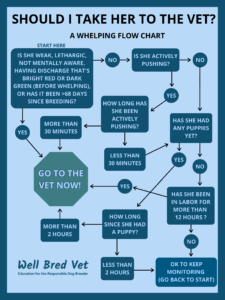You’ve fretted, planned, and fretted some more and now the big day is finally here: soon-to-be-momma is in labor! Between you and a pile of happy, healthy puppies lies several hours of anxiety –
Is everything progressing smoothly?
Is that discharge normal?
Is she pushing?
Has it been too long?
Are the puppies ok?
Does she need to go to the vet?
Is it still ok to wait?
10 more minutes?
5 more minutes?
To help you answer these questions, I’ve made this handy flowchart! Start in the upper left hand corner and follow the chart as the questions direct you. If you end up in the “stop sign,” it’s time to get momma checked by a vet!

Note that this flow chart prompts you to seek medical assistance if it’s been more than 2 hours between puppies. This is based on recent research from Cornell University. Their study evaluated whelping data from 2,489 litters and found that there is a significant increase in the percentage of stillborn puppies when the time period between puppies increased beyond 2 hours. Therefore, I’ve chosen to adjust my recommendation to only waiting 2 hours (as opposed to the previously-recommended 4 hours), because I want as many puppies to be born alive as possible.
It is important to note, however, than when the timeframe was greater than 4 hours, 63.5% of pups were still born alive, so the decision to seek medical assistance prior to 4 hours must be based on your individual goals. I tend to take the “better safe than sorry” approach, so adjust your approach accordingly!
To clarify – the 2 vs. 4 hour discussion is ONLY if momma is resting comfortably and NOT PUSHING. See the flow chart.
I hope you find this helpful! Please share with your friends, regardless of whether they are responsible breeders looking to maximize litter health or they’ve landed with a pregnant foster dog and they’re just trying to get through the night!
Let me know if you have any questions and I’d love to hear your stories of whelping success!
Want to get more content like this delivered to your inbox? Sign up for my email newsletter here!



4 Comments
Laura White · November 15, 2019 at 3:44 pm
What is specifically defined by “in Labor” in the the 12 hours in Labor before going to the vet? While I breed rarely, I am no novice. My Toller Bitch’s progression was exceedingly slow this litter. This was her second litter. First litter was “Normal”, though a day early, but we did not get a good pinpoint of ovulation). Also important to note that she is 9.5 years old, but Very Healthy and lively.
In this second litter, her temp dropped (but never dropped below 97.6) and nesting behavior, (Stage 1) for two days (day 61, 62 from ovulation), with milk dropping a day prior to that (day 60). This behavior escalated on day 63. The evening of Day 63 she went into the “Calm” Stage 2. (stages referred to me by my Reproductive Vet). I had made a tentative appointment for a C Section for the following Noon (Day 64), hoping that she would start contractions and whelp the 3 pups (yes I knew there were 3). She never did have ANY contractions and thus had a successful planned C Section with all 3 pups healthy and busy at about 2PM day 64. Propofol was used, so Mom was up almost right away and after getting the pups nursing (they immediately latched on) we went home.
Progesterone taken before C section was at 7.
I felt that a safe planned C section before allowing the pups to get stressed and potentially die was a good (though expensive) decision. This vet is almost 2 hours away, and while I could have gone to my regular vet who is closer for an emergency C Section (they do their own emergencies) I did not want to risk the dam or the pups. If she had been younger and there were more pups, I might have waited a little longer. Would you had advised perhaps a shot to get the ball rolling? I remember YEARS ago (Like 25) that if a bitch stalled in the middle of whelping one would give a “Pit Shot” to get the contractions going again. Tollers regularly DO reach the 2 hour mark between the “Y” changeover”. So I had stopped that practice a while ago. I note you have a 4 hour (If mother is resting and “Normal”).
Dr. Kristina Baltutis · November 19, 2019 at 4:16 pm
Hi Laura! Thank you for your questions!
The 12-hour timeline would be for the phase that you’re calling “Calm” Stage 2. In your example, since she started on the evening of Day 63 and hadn’t progressed by the morning of Day 64, I would have recommended exactly what you did – get to the vet and check the puppies, proceeding to C-section if there was any sign of fetal stress.
Using oxytocin (the “pit shot”) mid-labor was definitely MUCH more common in the past. I do not recommend it in most cases. It can cause dangerously strong contractions that can cut off oxygen to the puppies. Offhand, the situations I can think of where I would use it are 1) if the bitch is being monitored via Whelpwise (and in that case we use microdoses); or 2) if she is in the hospital so I can monitor fetal heartrates for stress AND there’s only 1 or maybe 2 puppies left.
In summary, it sounds like you did everything right! Thank you again for your questions!
Linda Wagner · September 13, 2023 at 7:08 pm
I just watched your video from Gooddog on whelping, that was done in October of ‘22. It was very Helpful.
I hope can remember everything. Our Daisy is due any day.
Thank you so much.https://wellbredvet.com/2019/11/13/whelpingflowchart/
6 Tips To Save Money While Still Being A Responsible Breeder – Well Bred Veterinary Services, PLLC · April 3, 2020 at 10:32 pm
[…] is most critical during whelping, because delays in action can result in dead puppies. Check out this flowchart for a starting […]